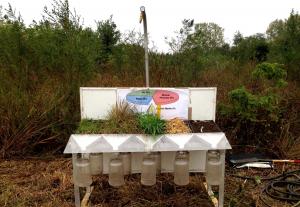What's Working for Conservation
Education
2018 Information
Soil Health Education: Soil health initiatives are gaining ground in southwestern Minnesota via cover crops and their many environmental benefits. Together, the Renville Soil & Water Conservation District (SWCD) and the Hawk Creek Watershed Project (HCWP) have undertaken several initiatives to promote soil health through cover crops and reduced tillage. The increased emphasis started in 2015 when the SWCD and HCWP offered producers cost-share options through Renville County water plan implementation funds and a Minnesota Pollution Control Agency grant. Promotional efforts are paying off. The number of cover-crop cost-share requests has increased 112 percent since 201Renville SWCD staff members have incorporated cover-crop test plots into several field days, starting with three plots in 2015 and adding three more in 2016. The focus this year is comparing annual vs. winter cover crops. Collaboration among Renville SWCD, Renville County and the HCWP has been essential to the acceptance of crop rotations including cover crops. At HCWP’s annual meeting this year, Jerry L. Hatfield, laboratory director at the U.S. Department of Agriculture’s National Laboratory for Agriculture and the Environment, said northern Iowa studies showed that 10 percent perennial vegetation appeared to be the tipping point for water quality in a watershed. With less than 10 percent cover, water quality dropped dramatically. Based partly on that information, the Renville SWCD Board of Supervisors set a goal of 10 percent including perennial cover (hay or set-aside acres) and cover crops in Renville County, the goal being to make soil health practices, like cover crops, a part of all farming operations.
Rainfall Simulator: In 2017, a rainfall simulator was purchased using Renville County Economic Development Authority funds plus local capacity grants from Renville, Redwood and McLeod SWCDs. The simulator allows comparisons of cropping systems, management and tillage techniques, and runoff and infiltration through the soil profile. “It is a great visual tool to show the effects of tillage and cover crops in a crop system,” said Holly Hatlewick, Renville SWCD manager.
2014-2015 Information
Adult Education: Adult education classes have been effective to teach native plant identification and growth. Three classes have been developed aimed at teaching participants how to:
1) Identify native plants and extract/collect their seeds (Fall Class)
2) Construct and use a grow light stand from 3 florescent light fixtures that will accommodate four 10 x 20 standard planting trays and stratify native seeds (Winter Class)
3) Sow, germinate, and transplant native plant seedlings grown under the light system that participants constructed (Spring Class).
Each of the classes are 2 hours in length, with significant prep time for the second one (I cut and pre-drilled all of the blanks for the light stand) The facilitator should have a good grasp on all of these steps, none of which are difficult, but they need to be familiar in order to teach and troubleshoot the processes. A similar thing could be facilitated in classrooms, with a project that wraps the entire year (Dan Schutte, Lake SWCD).
Prairie Workshops: WCD has held workshops that led to significant public participation in prairie restoration projects The SWCD advertised through newspapers, flyers posted at city halls, grocery stores, other public places, and on the web. The majority of those that attended planned to convert their lawn to native flowers and grasses, while some are converting crop land or pasture to native vegetation. They were excited about planting native plants and providing pollinator habitat but didn’t know where to start. A beekeeper presented for about ten minutes on bees - A root display supplied by Blue Thumb was used to show the different lengths of roots - during the presentation two volunteers come up and compare the 3 inch long turf grass root to the 15 ft. long lead plant root. A landowner also presented on why where, how etc. they planted prairie. The audience really enjoyed that part of the workshop. Sponsors from local seed suppliers and consultants, a bee farm, some townships and other organizations also participated; this helped cover refreshments and other expenses. The sponsors also donated door prizes (honey, plant ID books, etc.) and names were drawn at the end for the prizes. The workshops lasted about 1hr 15min and were a huge success; the majority of the participants wanted to go ahead with projects (Alyssa Alness, Scott SWCD).
2008-2012 Information
Schools and Restoration Projects: We have been effective in bringing local school groups into our restoration projects by: (1) having an education person on staff, (2) helping teachers tailor lessons around the restoration, (3) mixing classroom lectures and field trips, and (4) having excellent teachers to work with (Bill Bartodziej, Ramsey-Washington Metro Watershed District).
Public Perception of Projects: Native vegetation is not easy to establish on highly disturbed sites. Education is vital in dealing with the public’s perception of what the finished product will look like and the length of time it will take to get there. It has become apparent that ongoing maintenance will be required during the period of establishment which will take several years (Becker SWCD).

